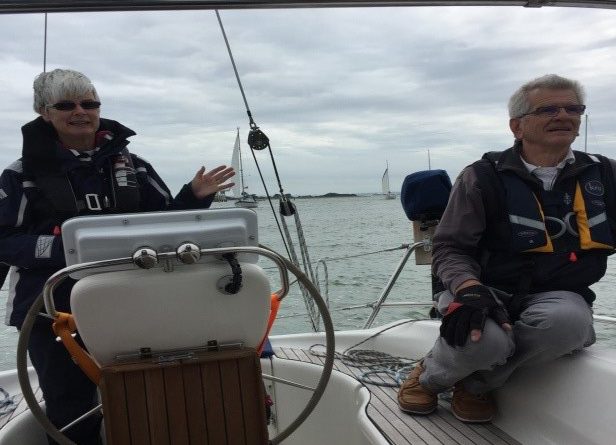Yachtie Ladies Learn the Ropes!
At recent meetings of the Yachtie Ladies, a number of our members agreed that they would like some time on the water to improve their boat handling competence, particularly in case something happened to their other half and they were left to deal with the situation by themselves.
Three ladies made their way to Universal marina on the Hamble and met up with Ian Culley where he keeps his yacht “Another Fantasy”. Ian is a qualified yachtmaster instructor so we were in good hands. The plan for the day was for us to learn how to cope in an emergency.
In the morning it was too breezy to go out but we went on board and discussed what safety equipment we should have both for ourselves and on the boat.
- The importance of wearing a lifejacket was top of the list. Several accessories were recommended: a lifeline (special floating rope) attached to the harness of the jacket and designed to float free when the jacket is inflated, thus increasing the chances of a quick ‘rescue’, a Loom-On by Spinlock which is a water activated light, and of course a hood to protect the face.
- Then we learnt about Epirbs (personal or for the yacht) – these send a distress signal direct to Falmouth – which is the National Centre for co-ordinating Search and Rescue operations.
- Handheld GPS (waterproof recommended) as a backup for main on board navigation system.
- Flares are not obligatory but a good idea, especially orange smoke which show the wind direction and strength for the benefit of rescue helicopter pilots, red parachute flares are useful to have as ‘attention-getters’ particularly at night, and the new electronic flare with LED for night time.
- A very powerful torch to be used as a search light.
- Gas alarm, smoke detectors and carbon monoxide detector.
- AIS is very useful especially when crossing the channel so big ships can see you. This is not a substitute for radar of course, as AIS only shows transmitting vessels, not necessarily small fishing boats.
- DSC radio. Did you know that when using a handheld radio, it needs to be held vertically to give the maximum range? That’s why the writer doesn’t always get heard when calling a marina!
- Life Ring – a small drogue attached will slow down the drift.
- A floating throwing line is very easy to deploy whereas a danbuoy really requires more crew.
- Jackstays should be made of webbing, rather than wire which is dangerous underfoot.
- The final piece of equipment we discussed was a “Handy Billy” for lifting a casualty back on board. We don’t know why it’s called a “Handy Billy”. We attached one end to the boom and the other to Ian’s lifejacket – he lay on the cockpit floor This was a 4 to 1 purchase, but it showed that a 6 to 1 would be more efficient or even 8 to 1 for lifting a large person.
After lunch the wind eased and we went out into Southampton water for a practical session. It was still somewhat windy gusting F5 at times. But we practised MOB. The yacht was stopped quickly by depowering the mainsail and heaving to. The engine was started and sails furled. The casualty (a fender) was brought alongside within 5 minutes. This manoeuvre seemed to be very effective but we were all determined now to go and practise this on our own yachts.
A big THANK YOU to Judy Walker for arranging the sessions and to Ian for his time and expertise. Such a useful day!
Several other dates for Ladies on the Water had been arranged but unfortunately they had to be cancelled due to unsuitable weather, but it is hoped to offer some further sessions for ladies later in the summer.
If you are interested in putting your name on the list please contact Judy Walker.
Helen Jupp

